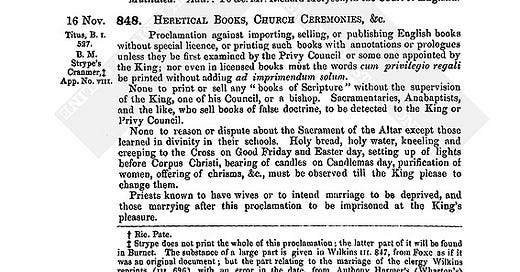The Act for Printers and Bynders of Bokes 1534
The use of statute to regulate the printing trade was directed primarily towards industry regulation rather than content regulation. Certainly there were statutes which prohibited the use of writing or printing as a means of expressing or as a constituent of heresy or treason[1], but these pieces of legislation had a goal other than the regulation of the printing trade.
In 1534, the Parliament of Henry VIII passed an Act for Prynters and Bynders of Bokes. Siebert[2] contends that this Act was part of a continuing arrogation of control assumed by the State over the printing trade, but it is suggested that it was part of a continuing concern that the state had regarding the way in which the trade was carried on in England.
Nor was there any need for novel steps to assert state control over printing. The prerogative had always claimed an interest in and an ability to control new inventions for the benefit of the community, and printing was no exception. The appointment of Royal printers by Henry VII and the grants of letters patent enabling the exclusive privilege to a certain printer to publish and certain title of class of titles was an established exercise of the prerogative that needed no added justification.
Most of the statutes dealing with the activities of aliens and denizens in industry in England in the early fifteenth century can be seen as protectionist, ensuring the interests of locally born workers, trades and craftsmen over and above those of aliens.
A decree in 1528 which was confirmed by legislation in 1529[3] prohibited aliens keeping more than two alien servants and any new shops, but it did allow foreign craftsmen to take native born apprentices. The import is clear. The decree prohibits the continued development of foreigners in trade, but at the same time it allows for the training of native born apprentices, so that in time English craftsmen would replace foreigners. It is also illustrative of a pragmatic approach to the introduction of new crafts and technologies from overseas. Printing is a specific example, but it is clear that to remain competitive, England had to keep up with developments and innovations on the Continent. Necessarily this required the presence of foreigners to introduce the new crafts, technologies or knowledge to England and to set up the new trade.
Keep reading with a 7-day free trial
Subscribe to A Halfling's View to keep reading this post and get 7 days of free access to the full post archives.



